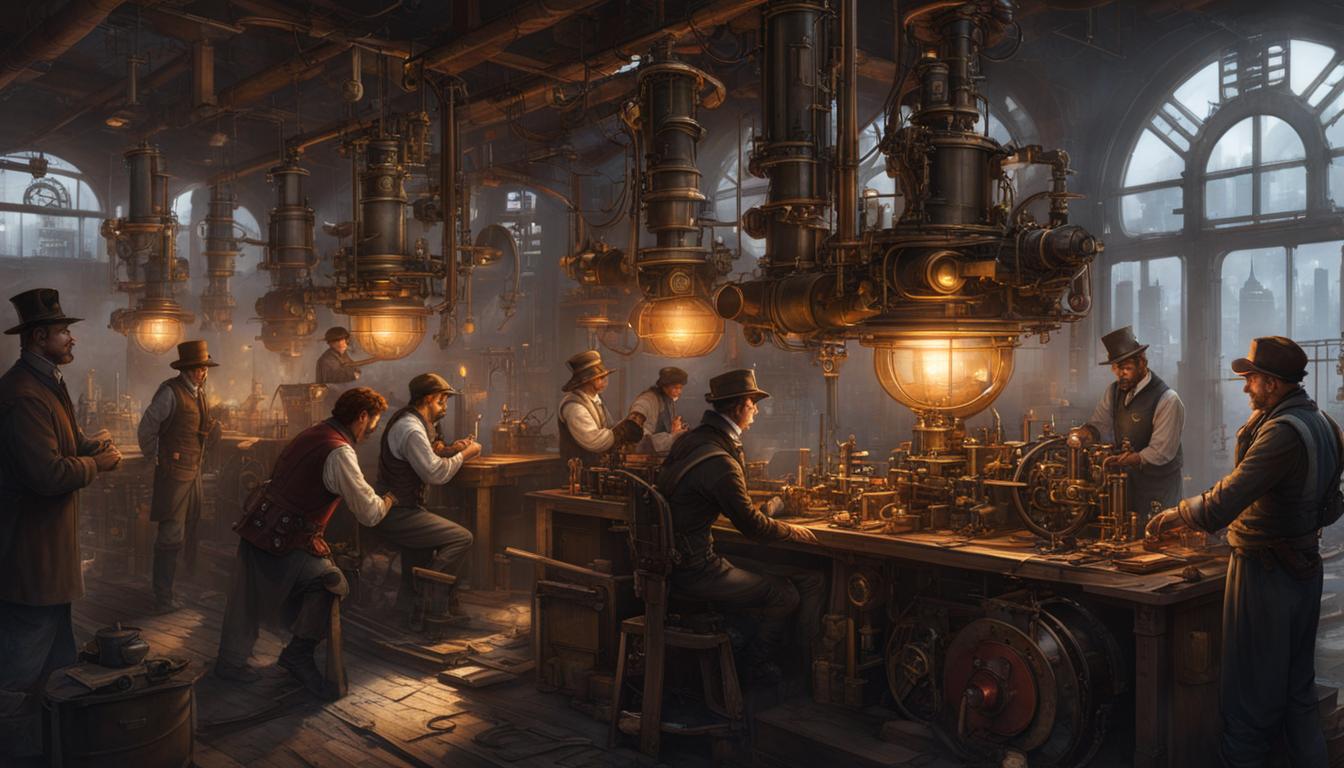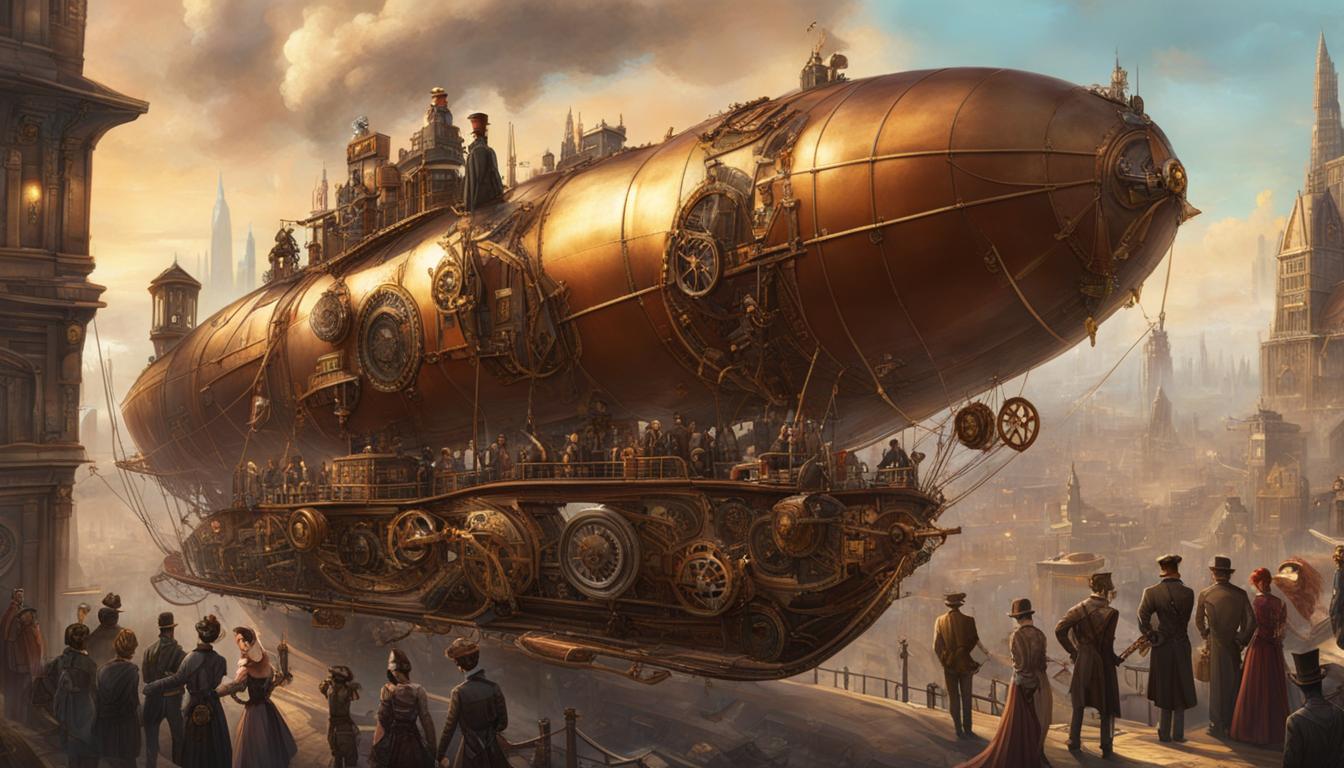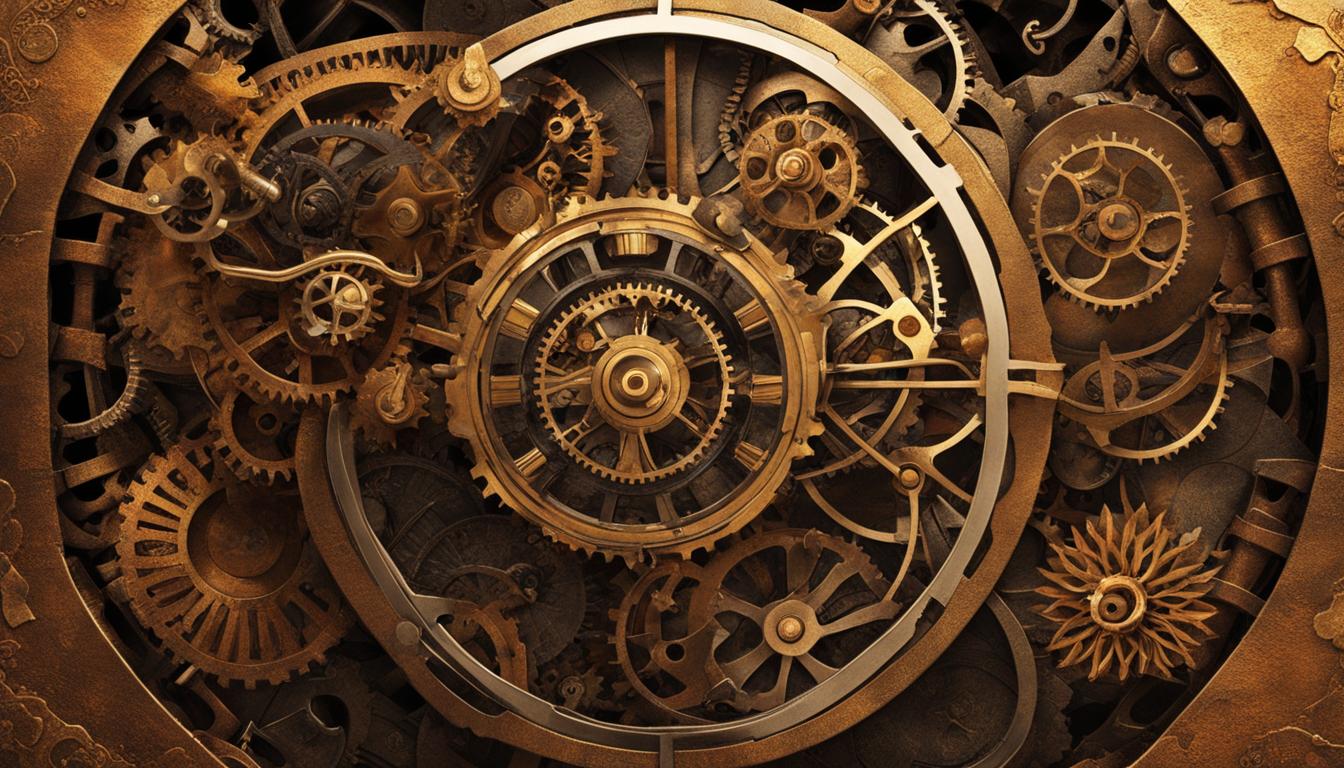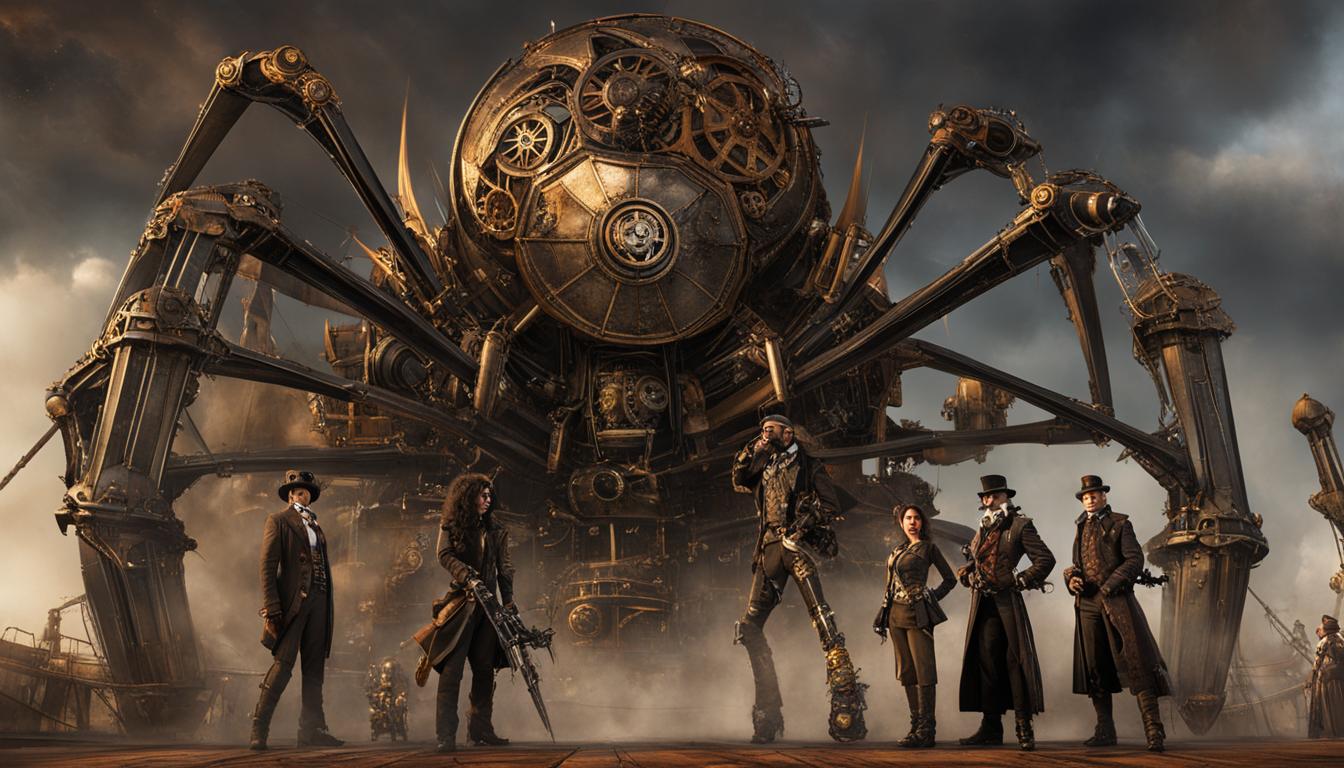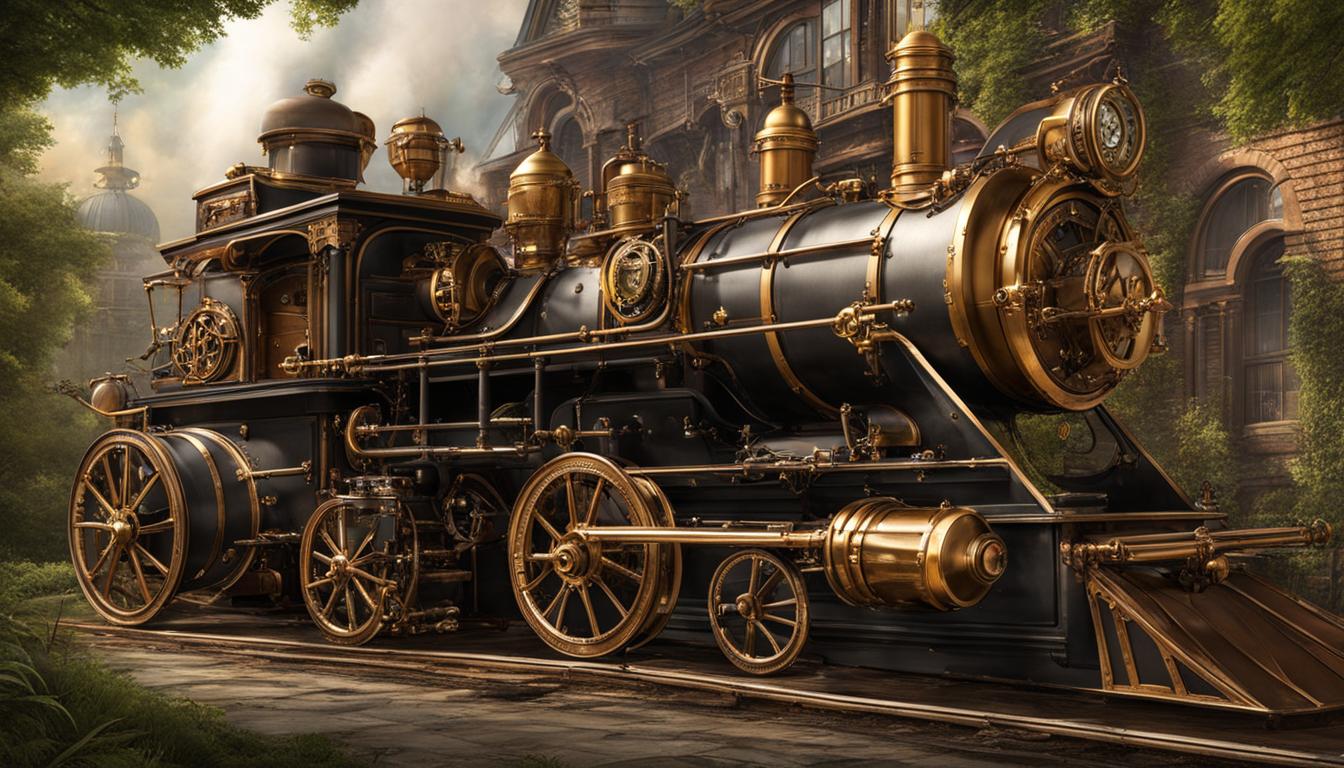Step into a world where science fiction collides with Victorian elegance, where steam-powered contraptions coexist with elaborate corsets and top hats. Welcome to the captivating realm of steampunk culture, a subculture that emerged in the late 1980s and early 1990s, fusing elements of science fiction, fantasy, and the aesthetics of the Victorian era. Delving into the origins of steampunk unveils a fascinating journey of creativity, imagination, and historical inspiration.
Inspired by the visionary works of authors like Jules Verne and H. G. Wells, steampunk paints a unique picture of an alternative 19th century, where steam-powered technology reigns supreme. The term “steampunk” was coined by science fiction author K. W. Jeter in 1987, marking the official birth of this captivating subculture.
Key Takeaways:
- Steampunk culture originated in the late 1980s and early 1990s, blending elements of science fiction, fantasy, and Victorian aesthetics.
- Pioneering authors such as Jules Verne and H. G. Wells laid the foundation for steampunk through their imaginative works.
- The term “steampunk” was coined by science fiction author K. W. Jeter in 1987.
- Steampunk culture draws inspiration from the Victorian era, incorporating its fashion, art, and technological innovations.
- Steampunk has grown into a thriving global community, with its own conventions and events.
The Influence of Victorian Era
The Victorian era, spanning from 1837 to 1901, had a significant influence on the development of steampunk culture. It was a time of technological innovation, industrialization, and a fascination with the future. Steampunk draws inspiration from the Victorian aesthetic, incorporating elements such as corsets, top hats, and gears into its fashion and art.
The strict gender roles and focus on propriety and etiquette of the Victorian era are often subverted in steampunk works, allowing for a sense of individual expression and creativity. Steampunk fashion showcases a daring combination of vintage elegance and futuristic elements, creating a unique and visually striking style.
Steampunk art, on the other hand, embraces the intricate designs and mechanical contraptions of the Victorian era. Paintings, sculptures, and photography in the steampunk genre often feature fantastical machines and fantastical landscapes, transporting viewers to a reimagined Victorian world.
The Influence of Victorian Architecture
One notable aspect of Victorian influence in steampunk culture is the architecture. The grand Victorian buildings and structures, such as the Crystal Palace and the Big Ben clock tower, have become iconic symbols of steampunk aesthetics.
| Victorian Architectural Features | Steampunk Adaptations |
|---|---|
| Tall spires and ornate facades | Steampunk buildings often feature exaggerated spires and intricate detailing, giving them a fantastical appearance. |
| Industrial elements such as iron and glass | Steampunk architecture incorporates industrial materials such as brass, copper, and glass to create a futuristic Victorian aesthetic. |
| Stained glass windows | Steampunk-inspired stained glass windows often depict fantastical scenes with airships, gears, and other steampunk motifs. |
The influence of the Victorian era is evident in both the fashion and art of steampunk culture. It serves as a foundation for the unique blend of history, fantasy, and technology that defines the subculture. Steampunk enthusiasts continue to draw inspiration from the Victorian era, creating their own interpretations and pushing the boundaries of creativity.
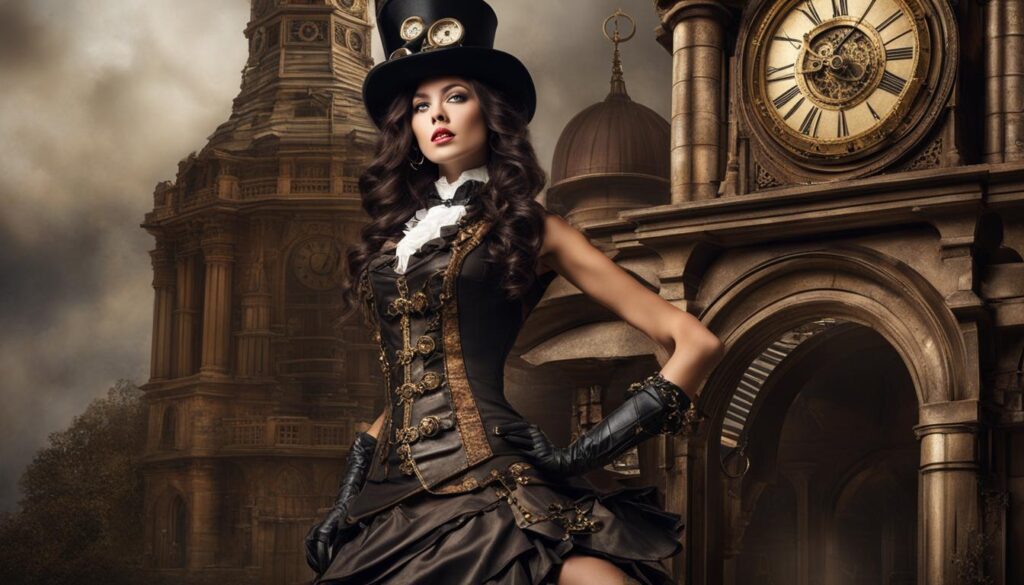
Steampunk fashion and art pay homage to the elegance and ingenuity of the Victorian era, while also embracing the limitless possibilities of imaginative storytelling.
The Birth of Steampunk Literature
Steampunk, as a literary genre, emerged in the 1980s, drawing inspiration from the works of authors like Jules Verne and H. G. Wells. These visionary writers imagined a world where steam technology was advanced and prevalent, creating stories of adventure, exploration, and mystery set in an alternative Victorian era. Their imaginative blend of science fiction and the Victorian era laid the foundation for what would become the steampunk culture we know today.
Early examples of steampunk literature include Jules Verne’s “Twenty Thousand Leagues Under the Sea” and H. G. Wells’ “The Time Machine.” These works showcased the possibilities of steam-powered technology and the intriguing juxtaposition of futuristic concepts within a historical setting. The combination of fantastical elements and the aesthetics of the Victorian era captured the imagination of readers and set the stage for the development of the steampunk subculture.
Steampunk literature not only entertained readers with gripping stories of adventure and innovation but also sparked the imagination of individuals who would go on to contribute to the broader steampunk movement. These early works laid the foundation for the distinctive blend of science fiction, fantasy, and Victorian aesthetics that define the genre. From the roots of literature, steampunk would evolve into a rich and diverse culture, encompassing fashion, art, music, and more.
Steampunk literature was a catalyst for the subculture, inspiring individuals to explore the possibilities of a reimagined Victorian era fueled by steam-powered technology. Its unique blend of history, fantasy, and innovation continues to captivate and inspire today.
The Influence of Early Steampunk Literature
The influence of early steampunk literature extended beyond the confines of the literary world. It sparked a wave of creativity and innovation, inspiring individuals to bring the fantastical visions of authors like Verne and Wells to life. From fashion to art to music, the foundations laid by early steampunk literature served as a catalyst for the birth of a thriving subculture.
- Steampunk Fashion: The distinctive blend of Victorian elegance and futuristic innovation seen in early steampunk literature inspired individuals to create their own unique fashion statements. Corsets, waistcoats, top hats, and goggles became iconic symbols of the steampunk aesthetic, allowing enthusiasts to express their creativity and individuality.
- Steampunk Art: The imaginative worlds and intricate inventions depicted in early steampunk literature also found their way into the realm of art. Paintings, sculptures, and photography showcased the attention to detail and mechanical wonder that define the steampunk genre. Artists embraced the fusion of history and technology, creating visually stunning works that captivated audiences.
- Steampunk Music: The soundscape of steampunk was also influenced by early steampunk literature. Musicians drew inspiration from the themes and atmospheres of the stories, blending traditional Victorian instruments with electronic elements to create a unique musical experience. Steampunk music transports listeners to a world where the past and future coexist in harmony.
These various artistic expressions, fueled by the foundations of early steampunk literature, continue to shape and evolve the steampunk subculture. They offer individuals a means of immersing themselves in a fantastical world where steam-powered technology reigns supreme.
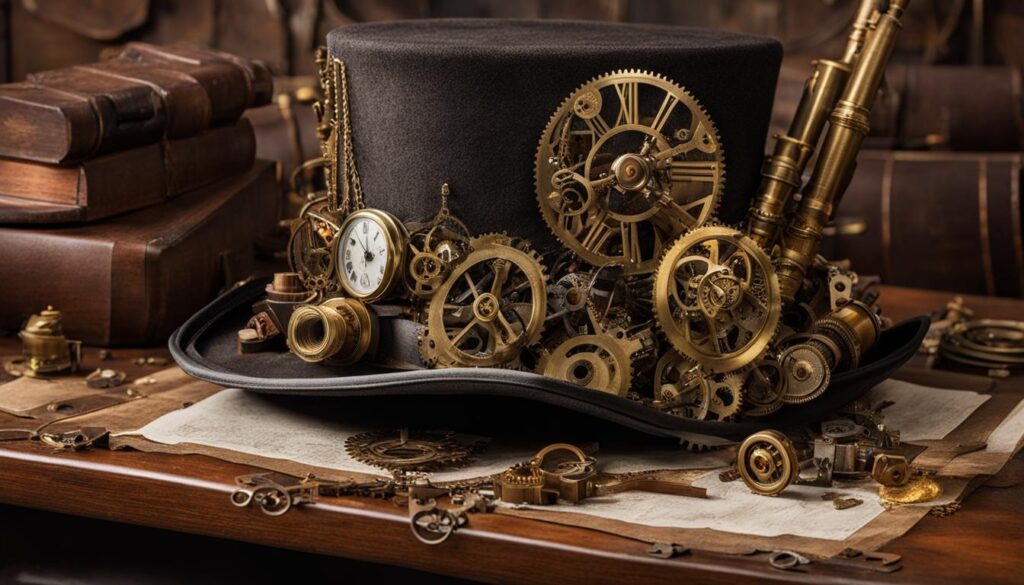
The Expansion into Fashion and Art
Steampunk expanded beyond literature to include fashion and art. Inspired by the Victorian era, steampunk fashion incorporates elements like corsets, waistcoats, goggles, and gears. It often features a mix of vintage and futuristic elements, creating a unique aesthetic. Steampunk art, whether in paintings, sculptures, or photography, often showcases intricate designs and mechanical contraptions. Both fashion and art in steampunk embody the creativity, attention to detail, and sense of nostalgia that define the subculture.
Steampunk Fashion
Steampunk fashion is a visual feast that combines the elegance of the Victorian era with a touch of industrial innovation. It is an opportunity for steampunk enthusiasts to create their own costumes and accessories, allowing them to unleash their creativity and showcase their unique style. The fashion of steampunk incorporates various elements, such as corsets, top hats, goggles, and gears, which are often intricately designed and carefully crafted. With its attention to detail and craftsmanship, steampunk fashion captivates both the wearer and the onlooker, transporting them to a world where past and future collide.
Steampunk Art
Steampunk art is a testament to the imagination and ingenuity of its creators. It encompasses a wide range of mediums, from paintings and sculptures to photography and digital art. Steampunk artists often draw inspiration from the Victorian era, incorporating elements like clockwork mechanisms, steam-powered contraptions, and fantastical scenes into their works. The result is a visual feast that transports viewers to a world where the boundaries of reality and imagination blur. Steampunk art celebrates innovation, nostalgia, and the enduring allure of the past, creating a sense of wonder and fascination among its admirers.
| Steampunk Fashion | Steampunk Art |
|---|---|
| Blends Victorian elegance with industrial flair | Captivating mix of fantasy, nostalgia, and innovation |
| Incorporates corsets, top hats, goggles, and gears | Features clockwork mechanisms and steam-powered contraptions |
| Allows for individual creativity and expression | Transports viewers to a world of imagination |
| Attention to detail and craftsmanship | Elicits a sense of wonder and fascination |
The Steampunk Community
Steampunk has evolved into a thriving community with its own conventions, festivals, and meetups. These events allow enthusiasts from all walks of life to come together and celebrate their love for the subculture. Steampunk communities create a space for connections, creativity, and exploration. Steampunk conventions, in particular, are known for their elaborate costumes, music performances, art displays, and opportunities for like-minded individuals to share their love for the genre.
The steampunk community is a diverse and welcoming one, with people of all ages and backgrounds coming together to express their passion for the subculture. Whether you’re a seasoned steampunk enthusiast or new to the subculture, you’ll find a warm and inclusive welcome in the community. It’s a place where individuals can let their creativity run wild, experiment with fashion, and showcase their unique skills and talents.
One of the highlights of the steampunk community is the conventions that take place around the world. These gatherings bring together thousands of steampunk fans for a weekend of immersive experiences. From workshops and panel discussions to fashion shows and live performances, there’s something for everyone to enjoy. The conventions often feature special guests, including authors, artists, and makers who have made significant contributions to the steampunk movement.
“Steampunk conventions are like stepping into a whole new world. The atmosphere is electric, and you can feel the excitement as soon as you walk through the doors. It’s a place where dreams come true and where you can truly be yourself. The energy is contagious, and the sense of community is unmatched. It’s a place where friendships are formed and memories are made.”
Table: Highlights of Steampunk Conventions
| Event | Location | Year Established |
|---|---|---|
| Steamcon | Seattle, Washington | 2009 |
| Steampunk World’s Fair | Piscataway, New Jersey | 2010 |
| Asylum Steampunk Festival | Lincoln, England | 2009 |
| Wild Wild West Steampunk Convention | Tucson, Arizona | 2011 |
| Watch City Steampunk Festival | Waltham, Massachusetts | 2010 |
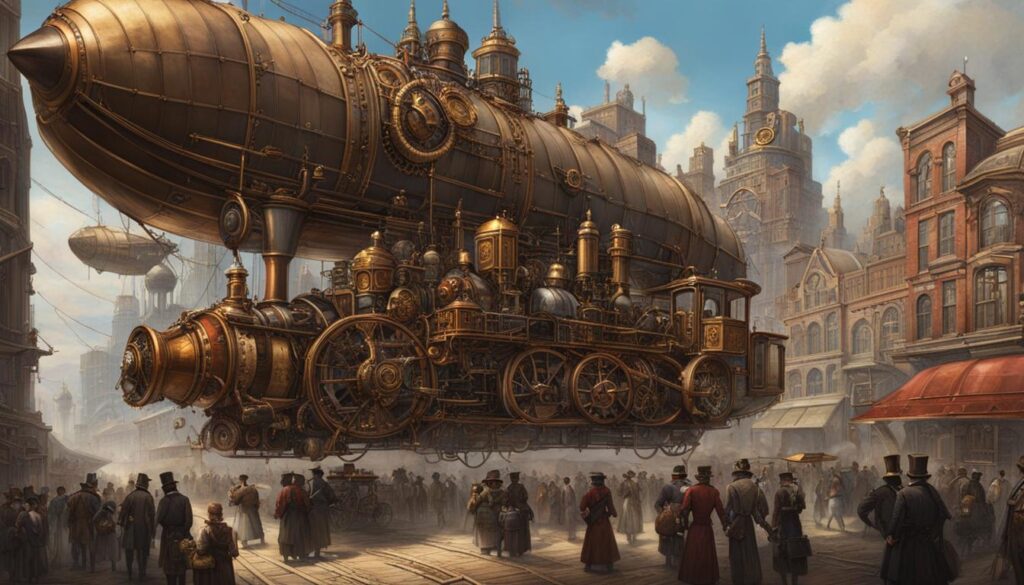
The Influence of Steampunk in Movies
| Movie | Release Year |
|---|---|
| “Wild Wild West” | 1999 |
| “The League of Extraordinary Gentlemen” | 2003 |
The Influence of Steampunk in TV Series
- “Penny Dreadful”
- “Doctor Who” (episodes with steampunk elements)
The Influence of Steampunk in Music
“Steampunk music is an eclectic mix of genres, combining elements of rock, folk, and industrial music with a Victorian-inspired twist.” – Music Critic
The Influence of Steampunk in Video Games
| Video Game | Release Year |
|---|---|
| “Bioshock Infinite” | 2013 |
| “Dishonored” | 2012 |
The Fascination with Steampunk Fashion
Steampunk fashion is a key component of the subculture, reflecting its blend of the Victorian era and futuristic technology. Enthusiasts of steampunk immerse themselves in a world where corsets, top hats, goggles, and gears take center stage. It is a unique aesthetic that allows individuals to express their creativity, embrace individuality, and pay homage to the aesthetics of the past while incorporating modern innovation.
The attention to detail and craftsmanship in steampunk fashion is a testament to the passion and dedication of its followers. Many steampunk enthusiasts take pride in creating their own costumes and accessories, utilizing a combination of vintage pieces and modern materials. They meticulously design and construct every element, from intricate corsets to elaborate headpieces, resulting in one-of-a-kind ensembles that are true works of art.
Steampunk fashion not only captures the imagination of its wearers but also serves as a form of self-expression. It offers a creative outlet for those who desire to step into a world of fantasy and adventure. By blending elements of the past and the future, steampunk fashion allows individuals to explore their own unique identity and showcase their love for the subculture.
The Evolution of Steampunk Fashion
The fashion of steampunk has gone through its own evolution since its inception. What started as a niche interest has now become a global phenomenon, with designers and retailers catering to the demand for steampunk-inspired clothing and accessories. Steampunk fashion can be seen not only at niche events and conventions but also on the runways and in mainstream fashion.
“Steampunk fashion is a perfect fusion of vintage elegance and futuristic innovation.” – Steampunk enthusiast
The fascination with steampunk fashion lies in its ability to transport individuals to a world that blurs the lines between the past, present, and future. It offers an escape from the monotony of everyday life and allows for the exploration of a fantastical realm where creativity knows no bounds. Whether it’s through the intricate details of a costume or the whimsical accessories, steampunk fashion continues to captivate the hearts and minds of its enthusiasts.
| Benefits of Steampunk Fashion | Drawbacks of Steampunk Fashion |
|---|---|
| Allows for self-expression and individuality | Can be expensive to create or purchase |
| Provides a sense of community and belonging | May not be suitable for all occasions |
| Combines elements of history, fantasy, and technology | Requires time and effort for costume creation |
Conclusion
Steampunk, a subculture that emerged in the late 1980s and early 1990s, has a rich history and continues to captivate and inspire individuals from all walks of life. Inspired by authors like Jules Verne and H. G. Wells, who envisioned a reimagined 19th century with advanced steam-powered technology, steampunk combines elements of science fiction, fantasy, and Victorian-era aesthetics.
From its humble beginnings in literature, steampunk has expanded into various artistic mediums, including fashion, art, music, and popular culture. The subculture’s unique blend of history, fantasy, and technology has resonated with a global audience, leading to its enduring presence in popular culture.
Steampunk’s vibrant community, with its own conventions and events, provides a space for enthusiasts to connect, create, and explore. With its attention to detail, emphasis on craftsmanship, and sense of nostalgia, steampunk fashion allows individuals to express their creativity and pay homage to the aesthetics of the past while incorporating modern innovation. The subculture’s influence extends beyond its community, inspiring movies, TV shows, music, and video games.
In conclusion, the origins of steampunk culture can be traced back to the works of pioneering authors and the fascination with the Victorian era. Steampunk’s inception as a subculture has evolved into a global phenomenon, captivating individuals with its unique blend of history, fantasy, and technology. As the subculture continues to grow and thrive, it remains a testament to the enduring power of imagination and creativity.
FAQ
What is steampunk?
Steampunk is a subculture that emerged in the late 1980s and early 1990s, combining elements of science fiction, fantasy, and Victorian-era aesthetics.
Who coined the term “steampunk”?
The term “steampunk” was coined by science fiction author K. W. Jeter in 1987.
What is the Victorian era?
The Victorian era spanned from 1837 to 1901 and was characterized by technological innovation, industrialization, and a fascination with the future.
How did the Victorian era influence steampunk?
The Victorian era influenced steampunk through its aesthetic, incorporating elements such as corsets, top hats, and gears into fashion and art.
How did steampunk start in literature?
Steampunk emerged as a literary genre in the 1980s, with authors like Jules Verne and H. G. Wells laying the foundation with their stories of adventure and exploration set in a reimagined Victorian era with advanced steam technology.
How did steampunk expand beyond literature?
Steampunk expanded to include fashion and art, with enthusiasts creating elaborate costumes and showcasing intricate designs and mechanical contraptions in their works.
What is the steampunk community like?
The steampunk community is a thriving one, with its own conventions, festivals, and meetups where enthusiasts can come together and celebrate their shared love for the subculture.
How has steampunk influenced popular culture?
Steampunk has inspired movies, TV shows, music, and video games, with its unique blend of history, fantasy, and technology capturing the imaginations of people around the world.
What makes steampunk fashion unique?
Steampunk fashion blends the aesthetics of the Victorian era and futuristic technology, allowing individuals to express their creativity and embrace individuality through corsets, top hats, goggles, and gears.
Source Links
- http://steampunkscholar.blogspot.com/2010/08/history-of-steampunk-by-cory-gross.html?m=1
- https://steampunktribune.com/steampunk-bible-and-steampunk-tribune-combine-to-create-one-amazing-source-of-steampunk-information/
- https://arcanetrinkets.com/unraveling-fascinating-world-steampunk-diving-into-origins-culture-steampunk/

